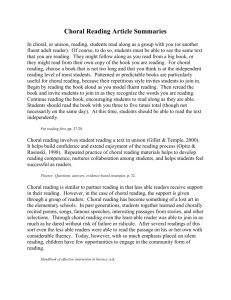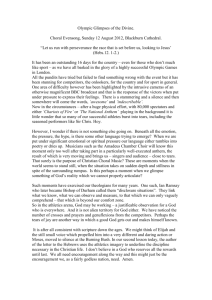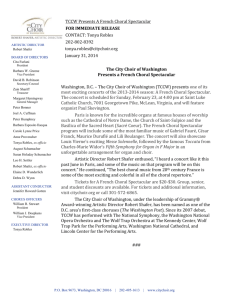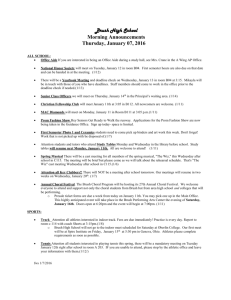4 Choral reading and shadowing
advertisement
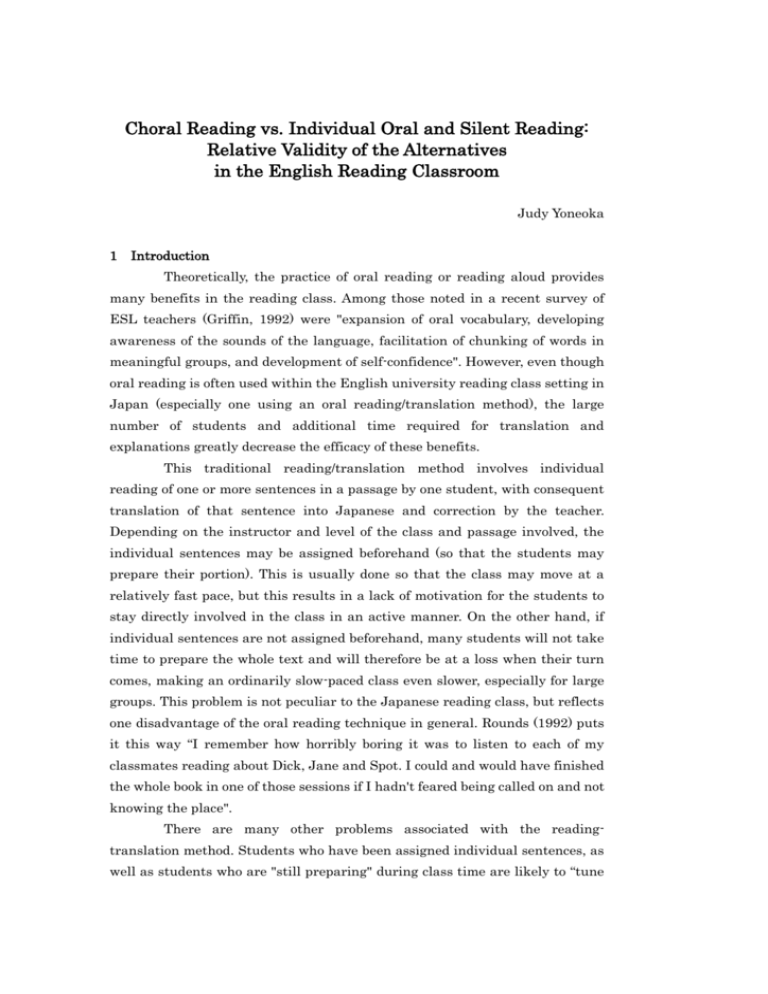
Choral Reading vs. Individual Oral and Silent Reading: Relative Validity of the Alternatives in the English Reading Classroom Judy Yoneoka 1 Introduction Theoretically, the practice of oral reading or reading aloud provides many benefits in the reading class. Among those noted in a recent survey of ESL teachers (Griffin, 1992) were "expansion of oral vocabulary, developing awareness of the sounds of the language, facilitation of chunking of words in meaningful groups, and development of self-confidence". However, even though oral reading is often used within the English university reading class setting in Japan (especially one using an oral reading/translation method), the large number of students and additional time required for translation and explanations greatly decrease the efficacy of these benefits. This traditional reading/translation method involves individual reading of one or more sentences in a passage by one student, with consequent translation of that sentence into Japanese and correction by the teacher. Depending on the instructor and level of the class and passage involved, the individual sentences may be assigned beforehand (so that the students may prepare their portion). This is usually done so that the class may move at a relatively fast pace, but this results in a lack of motivation for the students to stay directly involved in the class in an active manner. On the other hand, if individual sentences are not assigned beforehand, many students will not take time to prepare the whole text and will therefore be at a loss when their turn comes, making an ordinarily slow-paced class even slower, especially for large groups. This problem is not peculiar to the Japanese reading class, but reflects one disadvantage of the oral reading technique in general. Rounds (1992) puts it this way “I remember how horribly boring it was to listen to each of my classmates reading about Dick, Jane and Spot. I could and would have finished the whole book in one of those sessions if I hadn't feared being called on and not knowing the place". There are many other problems associated with the readingtranslation method. Students who have been assigned individual sentences, as well as students who are "still preparing" during class time are likely to “tune out" pronunciation of any vocabulary not specifically related to them. Also, the teacher is not likely to provide much in the way of a role model (except in the case of pronunciation of certain difficult words), robbing the students of the opportunity to develop fluency in suprasegmental factors such as intonation and liaison. There is not likely to be much repetition of any portion of any text. In addition, the extra time devoted to in-class translation means that the amount of oral pronunciation the students hear in any class period will be minimal. Even when concurrent translation is not involved, individual oral reading by students in Japan poses other difficulties, revolving around the reticence of Japanese students in general. This reticence results in 1) a tendency to avoid natural English intonation patterns in favor of a flat Japanese-language style delivery, 2) hesitation in order to avoid making mistakes in pronunciation, and 3) lack of voice projection. These then result in a decrease in the active interest of the other students toward the class and the material. Under such circumstances students are not likely to get much in the way of phonetic, lexical or morphological input unless they are highly self-motivated, and this will eventually have the effect of decreasing, rather than increasing, self-confidence. After all, most students are well aware that their own oral reading differs considerably from native speakers' renditions, as well as the fact that they study English for many years but do not pronounce it in class like they “should" (for whatever reason). And spending 60-90 minutes of class time listening to (for the most part) hesitant, monotonous deliveries of other students is not likely to improve their own skills very greatly. In the following, the advantages of choral or class reading as compared with individual oral and silent reading will be discussed. The interactions of choral reading with the phenomenon of subvocalization and the shadowing technique will also be explored. 2 Choral reading as an alternative In the survey mentioned above, the oral reading under consideration refer-red to individual rather than choral reading. However, especially in the large classes that make up most university English courses in Japan, choral reading can be considered a viable alternative to individual reading. As long as the instructor is able to provide a native-like pacemaking model (the teacher's own voice, a native team teacher or a tape) for the students to read with, the four advantages cited in the survey above and reiterated below should be just as valid, if not more so, in a group reading setting as in an individual one. Consider: 1) expansion of oral vocabulary-choral reading with a native or near-1lative pacemaking model provides a setting conducive to deriving meanings of unknown vocabulary from the context of the material, especially if the process is repeated several times and key vocabulary words are introduced between readings, 2) developing awareness of the sounds of the language – the pacemaking model not only provides an immediate pronunciation for unknown words which is simultaneously produced by the student, but also provides immediate feedback for words which students have mispronounced, 3) facilitation of chunking of words in meaning ful groups – choral readingnaturally leads students to read in “chunks”, following breaks between the word groups provided by the model. Kohno(1981, 1983) defines a “perceptural sense unit” as semantically based meaningful 7+ -2 syllables or less. Choral reading including pauses between such perceptual sense units provides a spontaneous model chunking which can be picked up by the students over time, 4) development of self-confidence – the constant, spontaneous and to a great extent unvarying feedback by the model provides a measure by which students can infer the extent of their own improvement, both in reading speed and understanding. Another advantage of choral reading is that it sets the stage for top-down processing as recommended by the schema theory. (This theory regards reading as an active process of deriving meaning by “educated guessing” using clues provided not only by the context of the material but also by the student’s personal general knowledge and world experience.) Prereading activities such as question/answer sessions, vocabulary introduction or picture interpretation can be used before such reading. In addition, if a text is chorally read several times, such activities may be introduced serially between readings, giving the students more and more clues to the overall meaning. Two possible objections to using a choral reading approach as opposed to individual reading are 1) the students have no opportunity to have their pronunciation corrected directly by the teacher, and 2) slower students might get lost in trying to keep up with the pace of the model speaker. In response to the first objection, it can be argued that the students actually are getting pronunciation training, directly and spontaneously, from the model speaker, in a way that is immediately reinforcing and nonthreatening. In addition, all students are more or less directly involved and <<tuned in", since the training is not directed at any time towards any one student, but towards all students simultaneously. Of course, evaluation of individual pronunciation is difficult in a classroom choral reading situation, but not impossible if done in an LL environment. Regarding the second objection, slower students who are not able to keep up and tend to “lose the place" often do pose a problem. Suzuki (1993) conducted a series of tests comparing students who listened to texts read without pauses with others who listened to the same text read by a model with pauses between perceptual sense units. In his study, the students listening to texts with pauses scored significantly better on follow-up tests than those who listened to straight text. This suggests a solution of using a model with variable lengths of hesitations between PSUs, possible with a CAI program, for example, or with a model tape which can be used in an LL at variable speeds. However, in Suzuki's experiment, the comparative total amounts of time that students listened to the stimuli were not reported. Thus it is highly probable that the pauses in the tapes played to the first group increased the overall length of time involved in the listening procedure to a significant degree as compared with the control group. If so, this difference in length of the entire listening time certainly would have played a role in the superior 1~esults of the listening-with-pauses group- In addition, the test scores were NOT significantly better in the case of low ability students (which of course is the group we are concerned with in connection to the second objection) unless the number of times the students listened to the material was increased. In connection with this, it would be informative to repeat such an experiment comparing results of students who listen to tapes with pauses between PSU's and students who listen to the same tapes without pauses, but played at a slower speed overall, so that the length of the overall listening time remained the same. Further possible objections to choral reading are that it may actually tend to slow down the faster-reading student, hindering instead of benefitting the overall reading process. Also, it can be argued that choral reading may tend to inhibit comprehension in students who read “phonetically" but without semantic processing. These two issues will be dealt with more fully in the next section. 3 Choral reading and subvocalization Subvocalization is defined as the subliminal pronunciation of phonemic sequences that make up words of a language during the reading process. According to Suzuki (1993), recent work in psycholinguistics has shown that subvocalization plays a necessary and important role in reading comprehension. Especially, work by Kadota (1987) concluded that exposure to a role model with regular English rhythm and intonation while reading silently significantly increases reading comprehension, presumably because the student is able to catch the structure of the phrases as well as the vocabulary essential to understanding. Also, Suzuki's own work with using oral models in conjunction with silent reading shows that this technique leads to an overall greater increase in reading speed, especially when coupled with comprehen-sion exercises. Arimoto (1989) has noted that in the case of poorer readers, this subvocalization is more remarked than in better readers, and that the phenomenon decreases with increase in reading speed. Thus a lack of subvocalization would point to increased reading ability, and is therefore desirable. Unfortunately, two of the most common reading methods in Japanese English education (the reading/translation method and silent reading combined with test comprehension questions) do not give students a chance to increase their speed to the point that subvocalization would not be present. In the first method, as already noted, this is because reading is involved only to the extent that a short passage is read aloud by one student at his or her own oral reading pace. In the second method, students will often not actually “read" a passage at all, but read the comprehension questions FIRST and then scan the passage looking for the correct answers. This type of “information hunting" leads the student to skip certain portions of the text and concentrate on others, a technique very useful in test problem solving, but highly unlikely to lead to an increase in general reading speed. However, if in the second method the comprehension questions are not introduced until after the reading is completed, such a problem is alleviated to some extent. What is the relationship between choral reading and the phenomenon of subvocalization? Choral reading does not lead to subvocalization on the part of students, but instead gives them a chance to “supervocalize", as it were, whatever subvocalization they are already doing in their minds. Even more, to the extent that the choral reading takes place at a speed at or above the student’s natural reading pace, it provides the sounds which would normally be subvocalized before the student has a chance to do this himself or herself. This leads to a kind of "flash card" effect: the audio stimulus is perceived, comprehended, correlated with the visual stimulus and reproduced more or less simultaneously. Over time, the visual stimulus will produce an audio response in the mind of the reader. This audio response differs from subvocalization in that the stimulus is not produced with the reader's own faulty speech patterns, but is an "echo" of the more fluent speech of the model. As Arimoto notes, when the silent reading speed of the student surpasses that of the spoken model, the effect of a model could lead the student to subvocalize more than necessary, having the effect of decreasing reading speed. However, the average silent reading speed of students has been shown to be around 60-110 words per minute (depending on the difficulty of the passage)1. On the other hand, the average speaking speed of the native speaker is more on the lines of 170 wpm, so this objection should not present a great worry until the students' reading speeds are greatly improved. What about the possibility of students reading “phonetically" but without semantic processing? Such students should show a relatively high oral reading speed, but low comprehension. In the group of 50 students tested by the author, 10 students (Group A) showed an oral reading speed which was at least 10 wpm higher than their silent reading speed. This type of student would seem to be a prime example of such a “phoneticizing" student_ Does choral reading really inhibit understanding for these students? To answer this question, comprehension test scores for this group of students were compared with those of two other groups of students: Group B, whose silent reading speeds surpassed their oral reading speeds by more than 10 wpm (N =21), and Group C, whose oral and silent reading speeds were almost the same (N =17). Comprehension test questions were divided into two groups: Q1-4, which tested the portion of the text read silently, and Q5-8 which tested the orally read portion of the text. The results were as follows: As can be seen from the results, for faster oral readers the scores for both comprehension sections, as well as the average reading efficiency are all 10-20% lower than those of the other two groups. These results show clearly that (1) students who read faster orally were the poorer readers in general and (2) although these students showed a generally lower ability in comprehension, it was not limited to only the sections read orally, but applied to the silently read sections as well. These results indicate that there is no clear adverse effect of oral reading on comprehension per se, but that higher oral reading speeds vis-a-vis the silent reading speed indicate poorer reading ability in general, and poorer comprehension in particular. Taking a second look at the data, it should be noted that the oral reading speed for Group A is only 5 wpm higher than for the other two groups. Indeed, it seems that we have been asking ourselves the wrong question concerning f2ister oral readers. For such students, the important point seems not to be "what makes the oral reading speed so fast?" but rather “what makes the silent reading speed so slow?" What are such students doing when they read silently? The answer to this question cannot be simply “subvocalization" as this cannot account for the marked difference in silent and oral reading speeds. Two alternatives come to mind: such students may either be rereading parts of the texts, or they may be translating as they read. In either case, oral reading prevents this type of reading hindrance in such students, leading to the relatively higher oral reading speeds. Of course, choral reading in the classroom would have the same effect, and should eventually lead to in-creased speed and confidence in silent reading for these students as well. 4 Choral reading and shadowing Shadowing, or spontaneous repetition of an aural model, is a technique often used in teaching simultaneous interpretation. It differs from choral reading in only one respect: there is no text present for the students to read from. As noted above, the average silent reading speed of most students is much lower than the average speaking speed of the native speaker. If the choral reading model is presented at this average speaking speed without pauses, it can be assumed that at least some of the choral repetition produced by the students is in fact shadowing. This leads to several questions: l) How much of choral reading is actually reading, as opposed to shadowing? 2) As the pacemaker model speeds up, are students likely to use a technique similar to shadowing to follow the text? 3) What model pace best induces shadowing? As conjectural answers to these questions, it was assumed that students are able to read perfectly when the choral reading is conducted at a rate lower than or equal to their own oral reading speeds (class average - 107.5). At a rate matching their silent reading speeds (class average - 116.8), they should be able to keep up using a combination of reading and shadowing techniques. However, when the rate surpasses their silent reading speeds, at least some of the words reproduced should be due to shadowing- To test these assumptions, a group of 50 students were tested in the following manner: l) Students' oral and silent reading speeds were taken by having students read ~110ud and silently and timing them. 2) In the LL, students chorally read at three different speeds: the first 100 wpm, just below the class average oral leading rate of 107.54, the second at approximately 145 wpm, a speed some-what below natural native speed, and the third at native speed (170 wpm). Their productions were recorded on tape. 3) The recognizable words and phrases reproduced each time were counted and compared. Interestingly, and contrary to expectations, some students were clearly able to follow the pacemaker quite well at all speeds, whereas others were not able to follow well no matter what the speed. Accordingly, those students who read at least 80% of the text at 100 and 145 wpm, and at least 40% of the text at 170 wpm were classified as "better choral readers". Students who failed to meet both of these qualifications were grouped as "poorer choral readers”. In order to clarify possible reasons for the difference in ability between the two groups of students, a comparison of reading data was made as follows: As is to be expected, poorer choral readers show poorer reading data in general_ Specifically, average oral reading speeds were 3 wpm below the class average, and 13 wpm below the better choral readers. In addition, there was a marked difference (9 wpm below class average, 20 wpm below better choral readers) in reading efficiency scores as well, indicating that a high level of general reading comprehension is a factor in choral reading ability. Also, in spite of the previously-noted fact that comparatively faster oral readers seem to correspond with a poorer reading ability in general, the percentage of such students is relatively low in the poorer choral reading group, but relatively high in the better choral readers. This indicates that an ability to read orally is highly connected with ability to read chorally. Contrary to expectations, there seemed to be only two students who applied any type of shadowing technique at the native reading pace. These students showed repetition patterns marked clearly by English-style intonation, but lacking in clear enunciation of content words. Almost all of the other students kept up with the native pace as best they could by using a sort of “read and jump" technique. These students would read as fast as they could with clearly marked Japanese pronunciation and intonation patterns, until they were obviously behind the tape. At this point, they would “jump ahead" to the next sentence or paragraph unit (or if they had totally lost the place, it sometimes took several paragraphs before they could find where the tape was reading) 2tnd begin to read again at their own speed. As an indicator that this was talking place, the percentage of students who read at least one word ahead after the tape model had stopped was 68.42% at the native reading pace, as compared with 0% at the lower two reading paces.3 On the other hand, at the two slower reading paces, it could be said that a type of shadowing was taking place. Although students were reading, most students would wait for the tape to “read" first before vocalizing. Especially at the lowest pace, the model's pronunciation and intonation patterns were raithfully copied, and at times instantaneous self-correction was observed (c. g. “Armenian" would be pronounced [a: meinien] first, then repronounced as [a: minien].) These results indicate that students are naturally more inclined to follow the pronunciation of models at lower speeds, but follow their eyes rather than their ears at higher speeds. This may be a result of lopsided training in reading vs. listening, and it is quite likely that an increase of training/ability in listening and speaking would lead to increased confidence and ability in choral reading as well. Conclusion As shown in the previous section, choral reading is an ability clearly possessed by some students but lacking in others. This ability correlates not only with a higher general reading ability, but also with higher comprehension. Thus, a combination of speed in oral reading coupled with a high ability in reading comprehension seem to be the main factors for choral reading ability. It is possible that, conversely, improvement in choral reading ability will lead to improvement in reading comprehension and speed as well. In a recent survey of approximately 100 students done by the author, the most difficult component of English on a scale from 1 to 5 was judged to be 「速読」or speed reading (ave. = 4 . 54, 4 . 2 for boys and girls respectively), over several other components such as listening comprehension and conversation. On the other hand, “reading for comprehension" 「読解」surprisingly was judged to be the least difficult for girls, and only “free composition"「自由作文」 was judged to be easier for boys (ave-3.8, 3.5 for boys and girls respectively). This shows just how difficult students regard reading at a faster rate of speed, probably due to their lack of experience with it. Choral reading is a technique which can be used to facilitate the “great leap" from reading for comprehension to speed reading. Of course, there should be some feedback measures included, such as post-reading comprehension questions or summary writing, in order to check the level of comprehension and clarify the material for the students. These may be used as factors for evaluation as well. It is also possible to use the level of participation in the choral reading itself (= number of words successfully read) as an evaluation factor of students' general reading ability. The reading of several complete novels within the framework of a single English university class is very rare. One of the reasons for this may be because both students and their instructors have not yet learned to combat what Krashen (1985) calls the “first few pages" effect. This refers to the special struggle encountered in overcoming the beginning pages of any novel, after which reading becomes much easier. The difficulty is not only due to the students' having to get used to a new author’s vocabulary, style, etc., as Krashen suggests, but also to the fact that many novels (especially those taught in literature classes) start out with relatively long descriptive passages with difficult vocabulary. One possible application of choral reading would be helping the students to get over such difficult passages. If the first few pages of a novel were read and discussed in class, this would give the students a schematic basis for reading the rest of the novel on their own. It would also awaken their interest, and impart the idea that it is not necessary to understand every word in order to get the “gist" of the message. Notes 1In my class, after 12 sessions of practice with choral reading and summarization of short stories, the average silent reading speed was 116.8 wpm. Other basic data were as follows: Class average choral reading speed Class average reading efficiency 2Due 107.54 88.97 to mechanical problems in the LL (approximately 15 machines did not function properly), and student error (i.e. not pressing the student recording button) during the experiment, only 31 tapes were usable. Of those 31, 4 were not classified as the students repeated very little or none of the text (either due to misunderstanding of the assignment or lack of interest). Of the remaining 27 tapes, 10 were classified as “poorer choral readers" and 17 as “better choral readers". 3Thirteen of the 19 students who successfully chorally read the last line of the native speed section, also read at least the first word of the next sentence even though the model had already stopped. One of the reasons for this striking difference was that the portion read at native speed ended in the middle of a paragraph, whereas the sections read at the other two speeds ended at ends of paragraph. However, this alone cannot fully account for such an extreme difference. References 有本、純(1989)「英語速読に関する諸問題」、 『熊本商大論集』第 83 号、p171-186. Griffin. Suzanne M (1992) "Reading Aloud: An Educator comments..." TESOL Quarterly Vol. 26, No 4, p. 784-787. Kadota, S. (1987) "The Role of Prosody in Silent Reading " Language Sciences. The East-West Sign Language Association Kohno, Morio (1981) “Effects of Pausing on Listening Comprehension" T Konishi ed. Studies in Grammar and Language, Tokyo, Kenkyusha Kohno, Morio (1993) “Perceptual Sense Unit and Echoic Memory." International Journal of Psycholinguistics, Vol 9, no. 1, Center for Academic Societies Japan. Krashen, Stephen D. (1985). The Input Hypothesis: Issues and Implications, Longman Inc, London and New York Rounds, Patricia L. (1992) “Another Educator Conunents", TESOL Quarterly Vol 26, No. 4, p. 787-790 Suzuki, Juichi (199 1) "An Empirical Study on a Remedial Approach to the Development of Listening Fluency: the Effectiveness of Pausing on Student's Listening Compre-hension Ability." 鈴木、寿一 (1993)「音声を兼用した速読指導法の有効性に関する実証的研究」、英 語教育研 No14, 日本英語教育会関西支部 Choral Reading vs. Individual Oral and Silent Reading: Relative Validity of the Alternatives in the English Reading Classroom Judy Yoneoka Abstract In this paper, the advantages and disadvantages of choral reading (group oral reading in class with a model) in relation to oral and silent reading were discussed. Also, the phenomenon of subvocalization and technique of shadowing were considered in relation to choral reading. In addition, an experiment was performed to determine the relationship of choral reading ability to follow overall ability and shadowing ability. It was found that students' ability to follow a model while reading chorally differed greatly, and that a higher degree of ability in choral reading indicated not only a higher oral reading speed, but a higher degree of overall comprehension as well. The results indicate that introduction of choral reading in the classroom would serve not only as an indicator of student ability and progress, but could also serve to improve pronunciation and intonation as well as reading comprehension.

